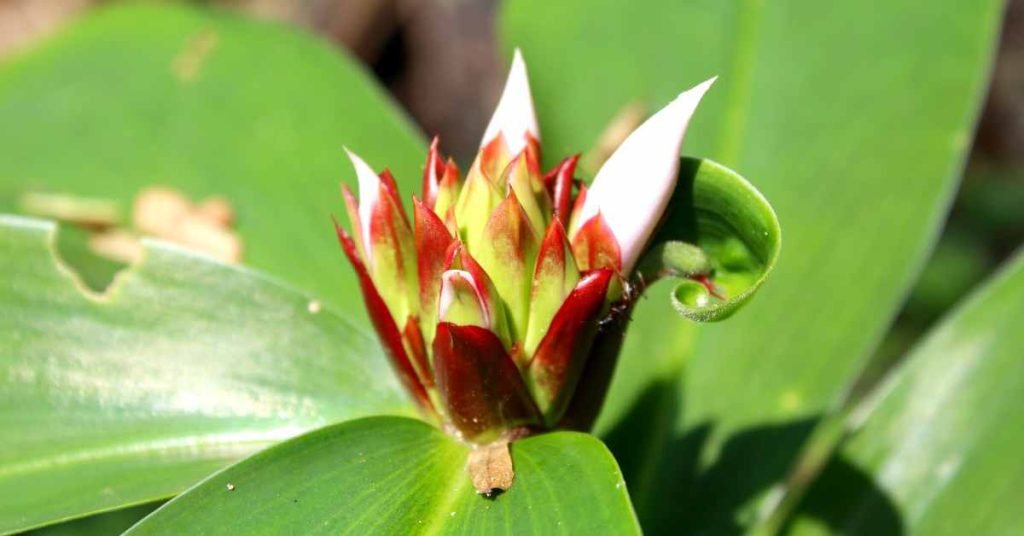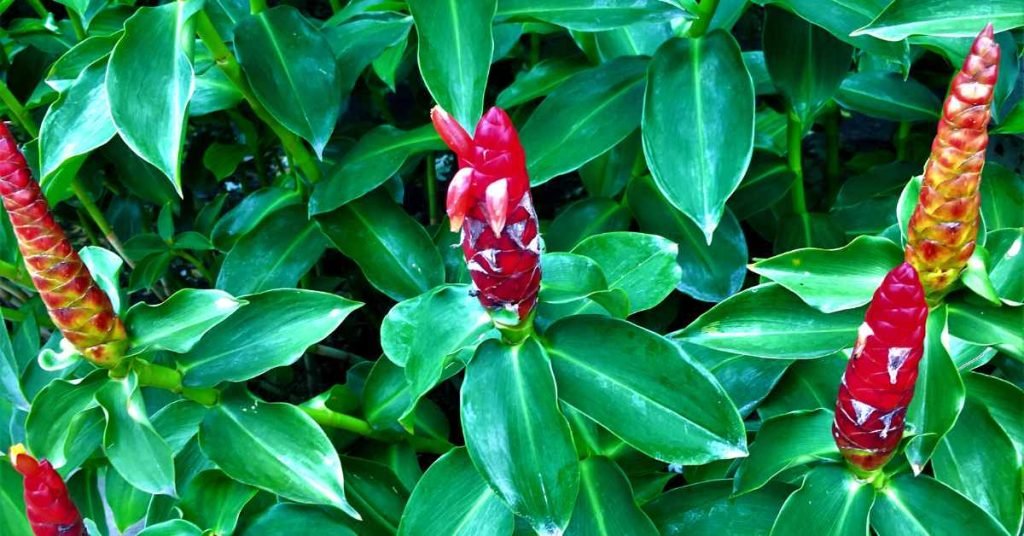Tea has long been celebrated as one of the most consumed beverages worldwide, appreciated not only for its diverse flavors but also for its potential health benefits.
Among the numerous varieties of tea, Spiral Ginger Tea stands out as a unique and revitalizing infusion.
Spiral ginger, also known as Costus igneus or insulin plant, is used to make herbal tea primarily from its leaves and stems.
This article delves into the origins, properties, and myriad health benefits of Spiral Ginger Tea.
Origin of Spiral Ginger Tea

The Spiral Ginger plant, scientifically known as Costus igneus, is a remarkable tropical plant with a rich history that spans several countries in South America, including Ecuador, Colombia, and Peru.
Let’s delve into the origins and significance of the Spiral Ginger plant in these regions:
Ecuador:
- Biodiversity Hotspot: Ecuador is renowned for its extraordinary biodiversity, and the Spiral Ginger plant is no exception. This country is home to numerous unique plant species, including the Costus spicatus. The lush rainforests, cloud forests, and diverse ecosystems provide an ideal habitat for this plant to thrive.
- Traditional Uses: In Ecuador, indigenous communities have utilized the Spiral Ginger plant for centuries. They have incorporated it into their traditional medicine practices. The plant’s leaves and rhizomes are often used to prepare infusions and poultices for various ailments, including digestive issues and skin problems.
- Cultural Significance: Ecuador’s indigenous cultures have deep-rooted connections with the Spiral Ginger plant. It often plays a role in their rituals and ceremonies, symbolizing the connection between humans and the natural world.
Colombia:
- Rich Flora: Colombia’s diverse geography, which includes the Amazon rainforest, Andes mountains, and coastal regions, provides a wide range of environments for plant life to flourish. The Spiral Ginger plant is just one of many intriguing species found in the country.
- Medicinal Applications: In Colombia, the Spiral Ginger plant is known for its medicinal properties. Traditional healers or curanderos have long employed this plant to treat various ailments, such as digestive problems, skin conditions, and even snakebites. The plant’s rhizomes and leaves are often used in folk remedies.
- Botanical Exploration: Colombia’s diverse flora has attracted botanists and researchers for centuries. The Spiral Ginger plant is of particular interest to scientists studying its chemical composition and potential therapeutic uses.

Peru:
- Rainforest Treasure: The Peruvian Amazon rainforest is a treasure trove of biodiversity, housing numerous plant species with unique properties. The Spiral Ginger plant is among the many medicinal plants that indigenous communities in Peru have utilized for generations.
- Traditional Medicine: In Peru, indigenous knowledge of the Spiral Ginger plant’s medicinal properties has been passed down through generations. It is considered an essential part of traditional medicine, used to address a wide range of health issues, including digestive disorders, fevers, and skin conditions.
- Conservation Efforts: The biodiversity of Peru’s rainforests is under threat due to deforestation and habitat destruction. As a result, efforts are underway to protect and preserve plants like the Spiral Ginger, which are not only culturally significant but also hold potential for future pharmaceutical research.
In summary, the Spiral Ginger plant, has deep cultural and medicinal roots in Ecuador, Colombia, and Peru. These countries’ lush landscapes and rich biodiversity have allowed this plant to thrive and become an integral part of traditional medicine and cultural practices. As the world recognizes the importance of preserving biodiversity and traditional knowledge, the Spiral Ginger plant remains a symbol of the intricate relationship between nature and human well-being in these regions.
Properties of Spiral Ginger Tea
- Rich in Bioactive Compounds: Spiral ginger is packed with bioactive compounds, the most notable being gingerol. This compound is responsible for ginger’s characteristic flavor and many of its health benefits. Gingerol is known for its antioxidant and anti-inflammatory properties.
- Vitamins and Minerals: Spiral Ginger Tea contains essential vitamins and minerals, including vitamin C, vitamin B6, potassium, and magnesium. These nutrients contribute to overall well-being and are vital for various bodily functions.
- Aromatic Essential Oils: Ginger contains volatile oils that lend their distinctive aroma and flavor to the tea. These oils, such as zingiberene and gingerol, not only enhance the tea’s taste but also provide therapeutic effects.
- Digestive Aid: Ginger has long been recognized for its digestive benefits. Consuming Spiral Ginger Tea can help alleviate digestive discomfort, reduce nausea, and promote healthy digestion. It is especially beneficial for individuals prone to motion sickness or morning sickness during pregnancy.
- Anti-Inflammatory Properties: The anti-inflammatory properties of ginger can help reduce inflammation in the body. This makes Spiral Ginger Tea a valuable addition to a diet aimed at managing chronic conditions like arthritis.
- Immune System Support: Vitamin C in Spiral Ginger Tea contributes to a stronger immune system. Regular consumption may help prevent colds and flu and speed up recovery when illness strikes.
- Antioxidant Defense: Ginger contains powerful antioxidants that combat oxidative stress and free radicals in the body. This may play a role in reducing the risk of chronic diseases, including cancer.

Health Benefits of Spiral Ginger Tea
- Lowers Blood Sugar Levels: Some studies suggest that spiral ginger is primarily used for lowering blood sugar levels and helping to maintain healthy glucose levels in diabetic and pre-diabetic patients.
- Relieves Nausea: Spiral ginger has long been used as a natural remedy for nausea, whether caused by motion sickness, pregnancy, or chemotherapy. Drinking Spiral Ginger Tea can help alleviate these symptoms.
- Reduces Inflammation: The anti-inflammatory compounds in spiral ginger may help reduce chronic inflammation, which is a leading cause of many diseases.
- Eases Digestive Discomfort: Spiral Ginger Tea can relieve digestive discomfort, such as indigestion, bloating, and gas. It aids in food digestion and helps maintain a healthy gut.
- Pain Relief: Spiral ginger has been found to have analgesic properties and may help reduce pain, making it a natural option for those dealing with arthritis or muscle soreness.
- Boosts Immunity: Regular consumption of Spiral Ginger Tea may help strengthen the immune system and provide added protection against common illnesses.
- Cardiovascular Health: The antioxidants in ginger may contribute to improved heart health by reducing the risk of heart disease and lowering cholesterol levels.
What Parts of Spiral Ginger Are Used to Make a Spiral Ginger Tea?
The leaves and stems are the most commonly used parts of the spiral ginger plant for making tea due to their potential health benefits. Here’s how you can make spiral ginger tea using these parts:
- Harvest the leaves and stems: Choose mature and healthy leaves and stems from the spiral ginger plant. You can pluck them from the plant, ensuring that you don’t damage the entire plant.
- Wash the leaves and stems: Rinse the harvested leaves and stems thoroughly under running water to remove any dirt or debris.
- Prepare the tea: There are several methods to prepare spiral ginger tea:
- Fresh leaves and stems: Chop the leaves and stems into smaller pieces and place them in a teapot or a cup. Boil water and pour it over the chopped leaves and stems. Allow the tea to steep for 5-10 minutes, or until it reaches your desired strength.
- Dried leaves and stems: If you prefer to use dried leaves and stems, you can dry them in the sun or in a dehydrator until they are crisp. Once dried, crush or crumble them into smaller pieces. To make the tea, use a teaspoon or so of the dried leaves and stems per cup of boiling water, and steep for 5-10 minutes.
- Flavor and sweeten (optional): You can add honey, lemon, or other sweeteners and flavorings to enhance the taste of your spiral ginger tea, though it is often enjoyed without any additions.

Final Word
Spiral Ginger Tea, originating from South America is a delightful infusion with a rich history and a plethora of health benefits. Its unique preparation, using spiralized ginger rhizomes and leaves, preserves the potent properties of ginger, including its anti-inflammatory, digestive, and immune-boosting qualities.
Whether you’re seeking relief from nausea, aiming to reduce inflammation, or simply looking for a warming and invigorating beverage, Spiral Ginger Tea offers a delightful and healthful solution.
Incorporating this aromatic and revitalizing tea into your daily routine may help enhance your overall well-being and provide a natural remedy for various ailments.
MEDICAL DISCLAIMER
Itsnevernotteatime.com cannot and does not contain medical/health advice. The medical/health information is provided for general and educational purposes only and is not a substitute for professional advice.




